NSW Farmers has partnered with the Future Food Systems Cooperative Research Centre and the University…
Farming towards a Net Zero future

Prime Minister Scott Morrison�s �technology not taxes� plan for a Net Zero carbon emissions future has put soil carbon and renewable energy in the spotlight.
Opposition leader Anthony Albanese also pledged a no regulations and taxes approach for agriculture if elected next year while meeting with NSW Farmers Members in Guyra this week.
With NSW Farmers President James Jackson�s farm as a backdrop, Members informed Mr Albanese and Shadow Minister for Climate Change and Energy Chris Bowen that carbon on farms is part of holistic cycle.
Mr Jackson told Mr Albanese that the unique role of agriculture in reducing emissions was missed by many, and it was time to set the record straight.

�As an industry agriculture is a huge consumer of carbon dioxide, removing millions of tonnes from the atmosphere and turning it into useful things like food,� Mr Jackson said
�It is our business to use biology to make all sorts of things out of carbon dioxide and water, no other sector uses carbon dioxide by the megaton like farmers do.�
�If we as a nation come away from Glasgow with an agreement that places more restrictions on agriculture instead of recognising its critical role in feeding and cleaning the planet, we will have failed to address the real issues of carbon emissions.�
NSW Farmers President James Jackson
Digging soil carbon for Net Zero future
Soil carbon is being touted as one of the key solutions for a Net Zero future, but the cost of measuring it on farm has hindered the adoption of carbon farming.
That is about to change according to Minister for Energy and Emissions Reduction, Angus Taylor.
Last September Minister Taylor released the Federal Government�s Technology Investment Roadmap, which highlighted soil carbon as one of five priority technologies to benefit from $18 billion of government investment.
�The Government�s Technology Investment Roadmap sets a goal of reducing the cost of measuring soil carbon by around 90%, to less than $3 per hectare per year,� Minister Taylor said.
�Our soils hold billions of tonnes of carbon already, and they can hold more as they become healthier and more productive. If we can get the cost of measurement down, this is a great opportunity for Australian farmers.�

The Minister launched the first stage of a $50 million National Soil Carbon Innovation Challenge last week.
The Challenge consists of multiple competitive grant rounds, including feasibility studies, proof of concept testing and validation and deployment through on-farm trials engaging land managers in new activities. Stage one, with total funding of $1 million, will provide grants of up to $100,000 for conducting three-month feasibility studies.
�The National Soil Carbon Innovation Challenge will support industry and researchers to bring forward new technologies like in-field soil probes and sensors, remote sensing and model-based approaches,� Minister Taylor said.
Further information on the National Soil Carbon Innovation Challenge, including eligibility guidelines for Stage one, is available at: https://business.gov.au/grants-andprograms/soil-carbon-measurement-innovation-challenge
Mulloon Institute welcomes soil carbon focus
The Mulloon Institute (TMI) has welcomed the Prime Minister�s plan to include Soil Carbon Sequestration to help reach a Net Zero carbon emissions future.
TMI is a not-for-profit organisation that is recognised globally as a demonstrator of sustainable agriculture and environmental regeneration through landscape rehydration and restoration.
Chair of the Institute, Gary Nairn AO, says soils hold three times more carbon than the atmosphere so has huge potential, through photosynthesis, to sequester carbon.
�Globally, soils contain more carbon than plants and the atmosphere combined. The solution therefore is literally right under our feet. The opportunity is now there to transfer it from the atmosphere and put it back where it belongs, in the soil.�

Mr Nairn said the key to carbon sequestration is water.
�Recognised as a global demonstrator of sustainable agriculture, the Mulloon Institute has a specific expertise in landscape rehydration and regeneration which not only addresses this issue, but in doing so, helps deliver potentially substantial financial returns for Australian agriculture and Australian farmers.�
�A hydrated landscape will speed up carbon sequestration. The better utilisation of rain when it does fall is crucial. Currently in Australia 50% of all rain that falls is lost through rapid runoff or evaporation due to poor ground coverage.�
�Carbon sequestration means healthier soils and more nutrient dense food. Increasing soil carbon is one of the substantial strategies required to reach net-zero. By regenerating our soils, we can sequester more carbon underground and slow global warming,� Mr. Nairn says.
How does carbon farming earn income?
According to A landholder�s guide to participate in soil carbon farming in Australia, an August 2021 paper by Richard Eckard, Robert White and Brian Davidson for the Australian Farm Institute, the Emission Reductions Fund offers the main avenue for landholders to earn income from soil carbon farming.
Participants create carbon abatements through approved land management practices to bid for offsets called Australian Carbon Credit Units (ACCUs) with one ACCU providing one tonne of carbon dioxide equivalent of abatement.
Landholders can choose to sell their offsets to the government, which counts as an offset to Australia�s reported emissions, or sell them in the more flexible voluntary market, where companies often use non-conforming methodologies that may not have the integrity of the rigorously vetted ACCUs.
Carbon credits sold to overseas investors cannot be counted as offsets to Australian emissions.
Balancing agriculture and renewable energy in a Net Zero future
Balancing agriculture, renewable energy and regional development will be critical in coming decades as Australia moves to a Net Zero future.
Land use is set to become a potential battleground for policy makers, but NSW Farmers Conservation and Resource Management Chair Bronwyn Petrie says there is a better way to balance food production and the environment.
�Agriculture is an industry like no other as it is vital to sustaining human life,� Mrs Petrie said.
�With a changing climate already affecting productive farmland, we need to ensure we protect the ability of Aussie farmers to help feed the planet.�
�This means putting the right development in the right place and including farmers in the decision making so we can secure our future.�

Australia�s agricultural output is growing despite high production costs and tough regulations � according to the NFF, each farmer�s labour feeds 600 people annually � 150 here at home and 450 overseas.
�This is a critical factor that�s sometimes missed in the climate debate � we have alternative fuels, but no alternative foods,� Mrs Petrie said.
�Net Zero is an important global goal, but so is food production and it�s crucial we have a system that acknowledges the importance of agricultural land and the fact that it�s a finite resource.”
�We are urging our state and federal governments to make sure productive agricultural land is properly classified, identified and protected.�
Mrs Petrie said policy positions on a range of matters relating to Net Zero and its potential impact on agriculture and regional communities had been established, and with appropriate planning and consultation, land use interests could harmoniously co-exist and deliver benefits for entire regional communities.
�With five new Renewable Energy Zones set for New South Wales, it�s important we get the energy transition right for regional communities, and central to that is consultation,� Mrs Petrie said.
�Regional communities stand to benefit from the energy transition, but there are placement issues. Therefore, we need assurance these projects will leave a positive legacy and they are appropriate for the amenity of the region.
�The Agriculture Commissioner needs to be a critical link between farmers and the government�s environment, land use and agriculture departments, and we support the scope of this role being broadened to ensure better long-term coordination.”
Want to have your say on the future of farming in NSW? Click here to learn how.








